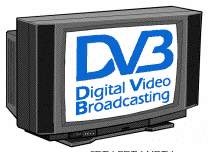
DVB transmissions may be received via a variety of equipment, but will typically be received by one of the following:


The next generation of digital recorders will provide much greater functionality than existing VCRs. By combining information held transmitted as MPEG meta-data prior to each programme, the digital recorder may itself determine whether the broadcast content should be recorded. This decision could for instance be done by matching the meta-data with a user-specified customer profile stored in the digital recorder. This profile also allows a future Electronic Programme Guide (EPG) to generate customised schedules.
The Multimedia Home Platform (MHP) is being defined to enable DVB receivers to be constructed in a common and provide common features and interfaces. DVB MHP uses the JAVA programming language (developed by SUN Microsystems) to access an Applications Program Interface (API) which gives access to DVB services. Using JAVA code, manufacturers can add additional capability to discriminate their products in the market place, as well as implementing industrial standard EPGs and user interfaces. Three application profiles have been defined:
The first MHP standards were defined in ETSI TS 101 812 (2000).
It has been claimed that the human eyesight is naturally more wide than high, and that by increasing the width of a TV picture, one can gain substantial improvement in the viewer experience. Certainly this format allows much more control by the viewer of the scene being presented - with the opportunity to focus on specific interests rather than following only the intended story line.. The UK has piloted a wide-screen service using "PALPlus" in 16:9 format. After much market survey, most people seem to acknowledge the advantages of wide-screen TV (as opposed to the traditional 4:3 screen format). The 16:9 format has been adopted as the standard for High Definition (HD) TV.
Attempting to view wide screen TV on a standard TV presents some problems - one either misses the left and right parts of the picture, or one sees the entire picture through a "letter box" which places broad black stripes across the top and bottom of the picture. Viewer surveys have shown that there has been considerable resistance to adopting a 16:9 "letter box" format for 4:3 TVs. It seems that the best way forward for traditional TVs is to adopt a small letter box, 14:3 which looses some information at each side, and introduces a small black band at the top and bottom of the picture. The plan is therefore to roll-out TV in 16:9 format (much TV is already produced in this format), but to "guard" the TV picture, ensuring that all essential material is captured in the central 14:9 portion of the display.
The purpose of a programme guide is to assist the viewer in selection of the programmes to be viewed. The guide will present a selection of information about the current TV programmes being shown, and the coming programmes. The programme guide is not bound to the channels being viewed, and it is feasible to see programme information from (phantom) channels which are not currently transmitting. The programme guide will carry all programme information, including regional variations, which it may not be possible to receive outside a specific area, within a common MPEG2 multiplex stream.
Two types of guides have been suggested: one simpler, allowing more flexibility, and resembling the TV listings found in newspapers; the other more sophisticated resembling a web-based TV magazine.
Event Schedule Guide (ESG)
The simplest type of guide resembles that provided by the analogue teletext system. This type of guide may be constructed by the receiver based on the Service Information (SI) contained in the MPEG2 multiplex stream. Transmitting the information in this way allows the receiver manufacturers and viewers to determine the presentation format - level of detail, preferred presentation style, channels of interest, type of programme desired, etc. A bit rate of about 50 kbps is required a weeks programme (assuming 5 channels of traditional TV).
Electronic Programme Guide (EPG)
An EPG presents an additional service to the user in the form of a multimedia magazine-style channel guide. This type of guide requires support in the manufacturers set top box for a consistent interface to allow the view of video stills, movie clips, buttons, layout, etc. It is expected that the look and feel for this type of guide will dictated by the service provider. EPGs have some considerable advantage when considering other services which may be provided: Home shopping, remote banking, etc. There is also a bigger opportunity for advertising. The cost is in the standardisation of the STB interface and the extra bandwidth consumed by the guide.
Most decoders will have software-based user interfaces implemented using a microprocessor. In many cases the microprocessor will also perform configuration and other house-keeping tasks associated with decoding the various MPEG2 streams. It has been suggested that the DSM-CC service could be used to reload and update this software over the MPEG2 broadcast link. This would use a DSM-CC object carousel to down-load each type of software (presently each STB will have its own architecture, and therefore will require a specific software image). To ensure that the software is always available it has been suggested that it should be encrypted with a key which is independent of the Conditional Access (CA) system, and the RSA key has been suggested. The details of downloading - and how to recover from faults - who is controls the software in the viewers STB, etc are still issues for debate.
See also :